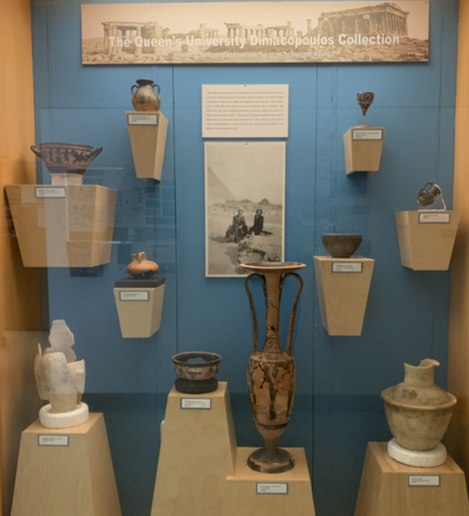The Diniacopoulos family arrived in Canada in 1951, bringing with them numerous priceless artifacts.1 Olga and Vincent Dinacopoulos worked in Montreal restoring and collecting art, while continuing to return to Europe to deal in art and acquire new artifacts.2 The collection included a wide range of objects from the Mediterranean and beyond, with dates extending from antiquity to the 20th century.3 Vincent passed away in 1967, marking the beginning of the slow dispersion of the Diniacopoulos’ collection, with just over 70 pieces making their way to Univerisité Laval the following year.4 Following the death of her son, Dennis, in 1997, Olga decided to leave the management of her collection to Concordia University. With their help her collection was dispersed to several private collections, and museums in North America and Europe.5 Some of these international institutions include the British Museum, the Louvre, the Metropolitan Museum of Art, the Royal Ontario Museum, and the Montreal Museum of Fine Arts.6
Items from the Diniacopoulos collection were acquired by Queens in 2001. The objects now at Queen’s come from throughout the Mediterranean, with dates spanning from the Greek Bronze Age to the late Roman Periods. The acquisition of these artifacts by Queen’s is an important addition to both the department of Art Conservation and Art History, and the department of Classics and Archaeology. Projects such as ours allow for student interaction, analysis and study of original artifacts. The acquisition of these items by the University allows for novel research of these unpublished materials. Six items from this collection are to be exhibited at Kingston city hall from April 5th, 2023-April 5th, 2024. Learn more about these items at the exhibition and through our team’s symposium talks on April 5th, 2023, at 3:00pm. Other items from this collection housed at Queen’s can be found at the Department of Classics and Archaeology on the 5th floor of John Watson Hall (image below).
Coins from the Diniacopoulos collection have their own dedicated website.
La famille Diniacopoulos est arrivée au Canada en 1951 apportant avec elle de nombreux artéfacts d’une valeur inestimable.1 Olga et Vincent Diniacopoulos travaillaient à Montréal restaurant et collectionnant des œuvres d’art tout en retournanten Europe pour faire du commerce d’art et acquérir de nouveaux artéfacts.2 La collection comprenait un large éventail d’objets, venant de la Méditerranée et au-delà, lesquels dataient de l’Antiquité au 20e siècle.3 Vincent est décédé en 1967, ce qui a marqué le début de la lente dispersion de la collection Diniacopoulos avec un peu plus de 70 pièces parties vers l’Université Laval l’année suivante.4 À la suite du décès de leur fils, Dennis, en 1997, Olga a décidé de laisser la gestion de sa collection à l’Université Concordia. Avec leur aide, sa collection a été dispersée dans plusieurs collections privées et musées en Amérique du Nord et en Europe.5 Certaines de ces institutions internationales comprennent le British Museum, le Louvre, le Metropolitan Museum of Art, le Musée royal de l’Ontario, et le Musée des beaux-arts de Montréal.6
Des objets de la collection Diniacopoulos ont été acquis par l’Université Queen’s en 2001. Les objets actuellement conservés à Queen’s, dont l’âge date de l’Âge du Bronze grec à la chute de l’Empire romain, proviennent du bassin méditerranéen. L’acquisition de ces artéfacts par Queen’s est un ajout important pour le département de restauration-conservation et histoire de l’art et pour le département d’études classiques et d’archéologie. Des projets tels que le nôtre permettent aux étudiant.e.s d’interagir, d’analyser, et d’étudier des artéfacts originaux. L’acquisition de ces objets par l’université permet de nouvelles recherches sur des matériaux qui à ce jour sont non-publiées. Six objets de cette collection seront exposés à l’Hôtel de ville de Kingston du 5 avril 2023 au 5 avril 2024. Apprenez-en plus sur ces objets lors de l’exposition ainsi qu’à la conférence donnée par notre équipe le 5 avril 2023 à 15h00. D’autres objets de cette collection conservés à l’Université Queen’s se trouvent au département d’études classiques et d’archéologie situé au 5ième étage du John Watson Hall (image ci-dessous).
Les pièces de monnaie de la collection Diniacopoulos ont leur propre site internet.

Image Caption. Exhibition case of artifacts from the Diniacopoulos Collection housed on the 5th floor of John Watson Hall.
Légende. Vitrine d’exposition des artéfacts de la collection Diniacopoulos conservée au 5ième étage du John Watson Hall.
1 Epstein 2004: 19; Blumer 2017: 21-2.
2 Blumer 2017: 15.
3 Epstein 2004: 19.
4 Epstein 2004: 26-7.
5 Blumer 2017: 54.
6 Blumer 2017: 53-4.
Sources
Blumer, Nadine. 2017, Finding Home: The Diniacopoulos Family and Collection. Montreal: Concordia University.
Epstein, Clarence. 2004, “A Timeless Classic: The story of the Diniacopoulos Family Collection” in The Diniacopoulos Collection in Quebec: Greek and Roman Antiquities, edited by J.M. Fossey and Francis J.E. Montreal: Musée des beaux-arts de Montréal, pp.17-26.